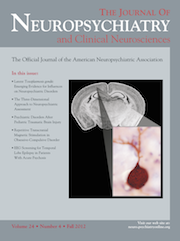Acute Onset of Parkinsonism With Reversible Course After H1N1 Vaccination: Insight From a Young Lady
To the Editor: Parkinsonian symptoms can be induced by acute encephalitis, syphilis, malaria, poliomyelitis, and sudden carbon monoxide poisoning.1,2 In this report, a 17-year-old girl had Parkinson's disease (PD) symptoms after a flu shot. So far, this is the first vaccine-related disorder that mimics PD. Our experience has shown that some parkinsonism can be cured with accurate diagnosis and appropriate treatment.
Case Report
A 17-year-old girl had a sudden onset of stiff limbs and movement difficulties after a flu vaccine shot. Her parents claimed that the symptoms appeared after receiving an H1N1 vaccine (AdimFlu-STM [A/H1N1]); Adimmune Corp., Taiwan). Physical examination showed that she had severe hypokinetic dysarthria, a mask-like face, bradykinesia, and generalized rigidity; these symptoms mimicked PD, although she had no history of the disease and neither did her family. Her urinalysis results were normal, and in the ophthalmologic tests, Kayser-Fleischer’s ring was not detected. Laboratory results showed normal serum levels of blood urea nitrogen (BUN), creatine, alanine transaminase (ALT), aspartate aminotransferase (AST), carbon monoxide, manganese, and calcium, with slightly reduced ceruloplasmin (17.9 mg/dL; normal: 20–60 mg/dL), and copper (616.94 ppb; normal: 700–1500 ppb) levels. Her cerebrospinal fluid (CSF) showed no lymphocytes, paraprotein, or oligoclonal banding. Results of multiplex reverse transcriptase-PCR were negative for various specific viruses in the CSF, such as influenza A, influenza B, RSV-A/B, adenoviruses, human metapneumovirus, rhinoviruses, HSV-1, HSV-2, CMV, enterovirus, and parainfluenza viruses. There were no abnormalities such as tumors, ischemia, or hydrocephalus on the brain MRI. We presumed that her fainting was induced by fear of injection and prescribed an antianxiety drug (alprazolam 0.75 mg per day) first, but the medication had no effect. We then suspected that the symptoms might be related to parkinsonism. Tc-99m-TRODAT SPECT was performed on the 5th day after onset of the symptoms, showing a marked decrease of dopamine transporter function in the striatum, indicative of parkinsonism. The patient was then put on antiparkinsonian medication. Amantadine sulfate and pramipexole (intravenous amantadine sulfate 200 mg per day for 7 days and oral pramipexole 0.375 mg per day for 35 days) were prescribed, and the patient’s symptoms gradually improved over the course of 10 days. The Tc-99m-TRODAT taken on the 10th day after the medication showed a remarkable recovery of dopamine transporter function in the basal ganglia. The patient discontinued the medication when the symptoms disappeared. Follow-ups after 1 year revealed no sequelae.
An increasing body of evidence indicates that “viral parkinsonism” or “post-encephalitic parkinsonism” is related to autoimmunity and neuroinflammatory mechanisms.3,4
Although we did not find a causal relationship between the vaccine and the acute severe parkinsonism responses in our patient, our experience sheds some light on the status of neural responses in patients receiving H1N1 vaccination and the medical care for this kind of illness. Some parkinsonisms are curable if we take accurate, prompt action after a thorough examination, even though we do not know the actual cause of this kind of movement disorder.
1 : Movement disorder emergencies. Curr Neurol Neurosci Rep 2005; 5:284–293Crossref, Medline, Google Scholar
2 : Movement disorder emergencies. Mov Disord 2005; 20:322–334Crossref, Medline, Google Scholar
3 : Encephalitis lethargica syndrome: 20 new cases and evidence of basal ganglia autoimmunity. Brain 2004; 127:21–33Crossref, Medline, Google Scholar
4 : Neuroinflammatory mechanisms in Parkinson’s disease: potential environmental triggers, pathways, and targets for early therapeutic intervention. Exp Neurol 2007; 208:1–25Crossref, Medline, Google Scholar



